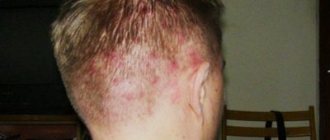Sexually transmitted diseases are one of the most serious psychological and social problems. Promiscuity and neglect of contraception lead to serious health consequences.
Infection occurs through blood, semen, genital secretions, and even through household contact. Therefore, the more we know about STDs and the more carefully we follow the basic rules of protection, the less risk we expose ourselves and the people around us.
call me back
Pimples on the pubic area - in women and men, causes, photos, purulent, red, why, big
Unlike acne on the face, acne on the pubic area is very often a sign of serious illness.
Therefore, not taking such rashes seriously can jeopardize not only your own health, but also put your loved ones at risk of infection.
Why do acne appear in the intimate area and what is the right thing to do if it is discovered?
- All information on the site is for informational purposes only and is NOT a guide to action!
- Only a DOCTOR can give you an ACCURATE DIAGNOSIS!
- We kindly ask you NOT to self-medicate, but to make an appointment with a specialist!
- Health to you and your loved ones!
Hair removal in the intimate area
More often, epilation of the pubic area is carried out by women, and therefore they also develop rashes associated with this more often.
The most common cause of acne after hair removal is the use of a razor.
Pimples that appear after shaving can be of two types:
- small red rashes scattered throughout almost the entire hair removal area - are formed due to a poor, dull razor, which injures the epidermis;
- single red or white pimples that cause discomfort - appear due to hair growing inward, first an area of inflammation is formed, and then bacteria are activated in it.
If any product was used to remove hair, the rash may be evidence of an allergic reaction to its composition.
In this case, the pimples will be small, located close to each other, but the entire area of the rash may be very itchy.
What to do if purulent acne appears on the pubic area
Regardless of whether men or women have purulent pimples on their pubic area, you cannot do without consulting a doctor.
purulent rashes in the intimate area
Only he can prescribe effective treatment, no matter how much you would like to solve the problem yourself.
Very often, the cause of ulcers is serious health problems or sexually transmitted diseases, therefore, by delaying a visit to the doctor, you thereby aggravate your disease and lengthen the period of struggle with it.
In men
- If a purulent pimple appears on a man’s pubis, the cause may be a simple lack of care or dirty laundry. Men work more physically and sweat. All these contaminants must be washed off daily with soap or a special product. But not all representatives of the stronger sex are advocates of hygiene, which is why blockage of pores often occurs. But if, despite all efforts to keep the intimate area clean, pustular rashes do not go away, you should consult a doctor.
- Another cause may be sexually transmitted diseases.
Purulent rashes that itch and cause discomfort and other unpleasant sensations require immediate consultation with a doctor.
Among women
In women, on the contrary, rashes in the pubic area can be caused by increased attention to this area, frequent hygiene procedures, shaving, and depilation. rashes can be caused by shaving the intimate area
rashes can be caused by shaving the intimate area
By the way, if there are purulent rashes, hair removal is contraindicated; this can provoke the spread of infection to healthy areas.
Hormonal causes and sexually transmitted diseases are also possible. Therefore, without a doctor and an accurate diagnosis, it makes no sense to take any measures.
Adviсe
Any disruptions in the body can cause rashes.
The skin always reacts sensitively to unfavorable changes, both external and internal.
Therefore, in order not to add to health problems, try to adhere to a healthy lifestyle.
Follow the principles of proper nutrition. Small errors from time to time will not cause harm to health, but why force the digestive organs to work at the limit of their capabilities all the time?
Choose your sexual partners carefully and use barrier methods of contraception. Sexually transmitted diseases are among the most difficult and long-term to cure.
Do not forget about daily hygiene procedures and changing linen.
Strengthen your immune system. Spend time outdoors every day, try to get enough sleep and be less nervous
These, at first glance, little things are important for the health of the whole body.
How to use the Darsonval device for acne? Find out here.
How to get rid of acne on a teenager's face? Read on.
Only a specialist can prescribe effective treatment.
Causes not associated with diseases
Most often, rashes on the pubis indicate the development of a pathological process. Less often, they do not cause any harm to the body. For example, sometimes red spots appear on the pubic area after shaving. This occurs due to the formation of small cuts on the skin. In this regard, it is necessary to change the blades in a timely manner. If stains appear after shaving, it is important to treat them with an antiseptic.
In addition, the following conditions may be the causes of rashes:
- Excessive sweating.
- Wearing tight underwear or items made of synthetic materials.
- Allergic reaction to hygiene products.
- Excess weight.
- Insufficient adherence to hygiene rules or their disregard.
If a rash appears on your pubic area, it is important to see a doctor immediately. Only a specialist can determine the cause of red spots on the pubis.
Treatment and home remedies
As you can see, genital sores can be caused by a variety of reasons, from a simple allergic reaction to serious STDs that should not be taken for granted. Therefore, it is necessary to consult a qualified doctor or gynecologist for diagnosis. Remember that pregnant women with ulcers may even endanger the lives of their unborn children if they are not promptly checked and treated. Depending on the cause of the problem, the following treatment methods are widely used:
- Antibiotics and antifungal drugs in cases of bacterial or fungal infections. They are available as oral or topical agents
- Hydrocortisone is used to relieve itching and therefore prevent scratching
- For STDs caused by viral infections, antiviral drugs can be of great help
- Depending on the cause of the itchy sores, corticosteroids may also be used
- For severe ulcers, painkillers and anti-inflammatory injections may be used
- Antihistamines are used to treat allergic reactions.
Apart from the above-mentioned medications, there are also some homemade products that can help reduce genital ulcers in women, especially in mild cases. They help kill bacteria and fungi that can cause sores, and gently exfoliate the skin, ridding it of dead cells, as well as unclog clogged pores and finally moisturize the tissues. Here are commonly used home remedies that can provide relief:
- Aloe vera
- Baking soda
- Apple vinegar
- Lemon juice
- Tea tree oil
- Coconut oil
- Rosemary oil
- Egg mask.
- Drink plenty of water daily to keep your skin hydrated
- Shower regularly and moisturize your skin after bath procedures. It is also necessary to bathe after physical activity that may cause you to sweat.
- Don't wear tight underwear
- Don't share sex toys
- Pubic hair should be cut, but not too short
- Get tested regularly for STIs or STDs
- Consult a nutritionist
- Avoid unprotected sexual intercourse, if necessary, have prior information about the STD status of your sexual partner
- Change body care products if they irritate your skin.
Any formation in the bikini area requires careful attention on the part of the wearer. Irritation on the pubic area can be either a normal rash or a sign of a dangerous disease that needs to be cured as quickly as possible.
Most often, it is quite difficult to distinguish the symptoms of irritation on your own. Therefore, you will need professionals. Be sure to go to the hospital to undergo a medical examination and determine the exact cause of the formations in this part of the body. As a rule, this takes no more than two days.
But initially you can independently guess what the problem is. If your pubic area itches, you may have serious health problems, including:
Tests for sexually transmitted infections
To find out whether a person is infected or not, there is a certain list of tests. As a rule, for more effective diagnosis, a combination of several types of tests is used:
— A smear on the flora. It is taken from the mucous membranes of the genital organs, less often from the mouth or anus. When the smear dries, the doctor examines it under a microscope.
— Bacterial culture. It requires a saliva/blood/urine/stool sample. The sample is placed in a substrate nutritious for bacterial growth. After 7-8 days, the causative agent of the disease can be determined, and their sensitivity to certain antibiotics can be analyzed.
— PCR diagnostics. This is a molecular genetic study, the accuracy of which is 95% and allows you to detect even hidden infections. Based on the method of repeated copying of DNA fragments.
— General and biochemical blood test. It allows you to identify inflammation and evaluate changes in organ function.
— Enzyme-linked immunosorbent assay (ELISA). It detects antibodies to STD pathogens. This allows us to identify both the current disease and past infections.
Acne is transmitted through sexual contact
Purulent pimples on the pubis may indicate the presence of diseases that are transmitted through sexual contact.
It can be:
- condylomas;
- genital herpes;
- molluscum contagiosum;
- lice pubis;
- syphilitic chancre
Genital herpes
Genital herpes is one of the most common causes of pubic acne. This disease occurs quite often and is transmitted mainly through sexual contact. The causative agent of herpes is a virus that is transmitted through unprotected sex. You can also get this virus from your partner if he has a so-called “cold” on his lips.
Within two to three weeks after infection, a person first experiences a burning sensation and slight itching in the pubic area, and then a rash appears there. Also, the patient is usually bothered by symptoms such as weakness, pain in the lower back, malaise and nagging pain in the groin area.
After a few days, the pimples burst, and in their place small ulcers form, which soon heal. As a rule, genital herpes has a recurrent course, so pimples may reappear after some time.
Most often, relapse is provoked by the following factors:
- stress;
- hypothermia;
- hormonal imbalance.
It is worth noting that if the disease is asymptomatic, then a person can become a spreader of the virus and infect many other people. Therefore, in case of genital herpes, it is recommended that both partners be examined.
Treatment of herpes, alas, is still only symptomatic. The fact is that scientists have not yet been able to create a drug that can rid the human body of the herpes virus.
Therefore, doctors usually prescribe antiviral drugs (mainly in the form of ointments based on acyclovir), which can not only relieve a person from the unpleasant manifestations of this disease, but also prevent repeated relapses.
Molluscum contagiosum
This disease is transmitted from person to person through sexual contact. Its causative agent is poxvirus. As a rule, this disease has a very long incubation period, during which a person does not even realize that he is sick.
After the end of the incubation period, rashes appear on the pubis. These pimples are somewhat different from ordinary ones - they are dense pink papules with a shiny surface. When you press on the papule, there is no pain, but a cheesy mass begins to ooze out of it.
Pediculosis pubis
Infection with this disease usually occurs through sexual contact or through household objects. The cause of such head lice is pubic lice. This disease is quite simple to both diagnose and cure.
The first sign of lice pubis is a feeling of discomfort and itching in the pubic area. After this, rashes and skin irritation occur. Pimples form not only on the pubis, but also on the external genitalia. They are red in color and cause a lot of discomfort to the patient, as they itch a lot.
Syphilitic chancre (syphilis)
It looks like an ulcer, the edges of which are shiny, and appears on the pubis, labia, penis, and vagina. After a while, a pink rash appears in its place. Treatment is prescribed by a dermatologist-venereologist.
Molluscum contagiosum
This term refers to a pathological condition of a viral nature. Both men, women and children are susceptible to the disease. The pathogen is transmitted not only during intimate intimacy, but also through contact and household contact.
The main sign of the disease is red spots on the pubis, scrotum, labia or penis. The rashes have the shape of a hemisphere. Often, nodules then form, and when pressed, a plug of curdled consistency emerges.
The red spots do not itch or flake, and they are also not painful. The genital form of the disease does not require treatment. In most cases, the rash disappears on its own within 2-3 months after its appearance.
If the spots are located in such a way that they are often injured, your doctor may recommend removing them in one of the following ways:
- curettage;
- cryodestruction;
- husking;
- laser excision;
- electrocoagulation.
Such treatment is carried out only in extreme cases. This is due to the fact that scars remain on the skin after the intervention.
General characteristics of a rash on the pubis
A rash on the pubis can appear as a purulent boil, as well as in the form of ulcers, acne or plaques. There are several main causes of epidermal lesions in the pubic region:
- The dermatological nature of the rash refers to a chronic disease that promotes purulent inflammation on any area of the skin, including the pubis. The internal pimple in the groin has a yellowish color with plaques.
- Sebaceous gland cysts often appear on the labia and head of the penis. They are a small white element that is located under the skin. Plugged cysts can grow large and become quickly inflamed and painful. On the pubis, cysts look like acne. It is strictly forbidden to squeeze them out yourself.
- Pediculosis of the scalp or phthiriasis occurs due to bug bites. Damage occurs that has a blue-blue color. The infection enters the bloodstream along with the insect's saliva. The disease is accompanied by itching. If there is no treatment, then soon large inflammations filled with pus appear at the site of acne.
- Psoriasis infections are chronic diseases that have an autoimmune mechanism of development. The cause of psoriasis lies in heredity, intensive drug therapy and the mental state of the person. Most often, the rashes are wavy in nature, then they appear, then the skin becomes smooth again. In the acute stage, the rash becomes red.
- Dermatophytosis is a fungal infection of the epidermis. Pimples in the pubic area are oval-shaped and pink in color; often the rashes are filled with purulent fluid. The skin of the affected area peels off and swelling forms. Pubic hair begins to fall out.
- Banal scabies occurs due to tick bites. Swelling and blisters with liquid form at the site of the lesions. The rash is treated with iodine. If the acne becomes noticeably darker, the disease is progressing.
- Genital herpes is a cold that is widespread among the population (more than 20% of people are infected). In an intimate place, for example, a pimple on the labia appears in the form of a vesicle. Clear or purulent liquid accumulates inside. The disease can be caused by hypothermia, weak immunity, or pregnancy. In the first stage, pubic acne causes pain and a feeling of heaviness, numbness in the pelvic area, especially after prolonged sitting or sleeping at night, as well as an increase in body temperature.
- Damage to the skin during shaving. The wounds must be immediately treated with an antiseptic (hydrogen peroxide, chlorhexide, iodine).
- Pubic rash in women and men can be caused by allergies. The groin area is sensitive and delicate, so it can be the first to react to any irritant (washing powder, pet hair, medications, cosmetics, synthetic laundry fabrics).
By the name rash on the pubis, patients mean completely different formations. In addition to complications associated with dermatology, allergies, decreased immunity, the causes of infection are viruses: staphylococci, chlamydia, E. coli and other microorganisms.
A little more information about infectious diseases can be gleaned from the video.
Symptoms of STDs in men
Men can assume that they have sexually transmitted diseases based on characteristic symptoms:
- Discharge from the urethra. They may be whitish in color, accompanied by pus and an unpleasant odor.
— Problems with urination: pain, cramping, too frequent/false urges, the need to urinate at night.
— Cutting pain, discomfort, itching, burning in the head of the penis.
— Unpleasant sensations in the pubic area and/or lower abdomen.
- Redness, rashes on the glans penis and/or foreskin.
— Sexual dysfunction: premature ejaculation, increased sensitivity during sexual intercourse, weak erection, lack of desire.
- Enlarged inguinal lymph nodes.
- Peeling, cracks in the tongue.
- Yellowing of the whites of the eyes and skin (in the case of hepatitis B).
— Sore throat (if infection occurred orally).
— The occurrence of proctitis (inflammation of the rectal mucosa). Appears if infection occurs through the anus. Proctitis develops over several hours and is characterized by pain in the anus and rectum.
Also, an STD may be accompanied by fever, general weakness, chills and headache.
The clinical picture of an STD may initially appear gradually and indirectly. Therefore, the appearance of any symptom should be an alarm bell and a reason to visit a urologist.
The increase in the number of cases of STDs is associated with the following factors:
- frequent change of sexual partners;
- lack of habit of using condoms;
- neglect of the appearance of symptoms;
- self-medication.
Causes
Rashes localized in the pubic area differ in appearance, size, shape, structure, etc. Taking into account the peculiarities of the visual manifestation of this symptom, the following list of diseases is determined that are characterized by the appearance of pimples on the pubis:
Pediculosis pubis. Infection with the causative agent of the disease - pubic lice, as a rule, occurs through sexual contact with a carrier of parasites, as well as common household items, personal hygiene, etc. The incubation period of the disease is one month. The first signs of its development are intense itching and burning in the groin area, irritation of the skin, and the formation of red pimples on the pubis at the sites of parasite bites. Due to constant scratching of the affected areas, patients with lice pubis are at risk of infection with pathogenic bacteria. In the complex treatment of the disease, local therapy with antiparasitic agents (ointments, shampoos, creams, etc.), special treatment of the patient’s bedding and underwear (thorough washing and ironing on both sides), as well as household items used by the patient (mattresses) are used. , upholstered furniture, etc.). Genital herpes. Against the background of infection with the herpes virus, which is highly contagious and sexually transmitted, a small pimple on the pubis may form, looking like a vesicle filled with greenish-yellow liquid exudate. One such formation quickly develops into multiple rashes, intense pain, burning and itching sensations appear. Patients also experience general weakness, malaise, nagging pain in the groin and lower back. After some time, the vesicular pimples burst, forming small, quickly healing ulcers. But since genital herpes is characterized by a constantly relapsing course, the rash soon appears again. Stress, hormonal imbalance, and hypothermia can trigger a relapse. Treatment of genital herpes, based on taking antiviral drugs, is symptomatic. This approach makes it possible to significantly reduce the intensity of the symptoms of the disease and increase the period of time between periods of its exacerbation. Molluscum contagiosum. Infectious pathology, the causative agent of which is a poxvirus, is usually manifested by the formation of pimples on the pubis, which look like dense pink papules with a shiny surface. If you press on such a pimple, there will be no pain, but a characteristic cheesy exudate will be released. Infection with molluscum contagiosum occurs at the moment of contact between healthy and virus-infected skin. Before the first symptoms of molluscum contagiosum appear, there is an incubation period (up to two months), during which the patient may not even be aware of the developing disease.
Given the high risk of virus transmission, it is necessary to pay timely attention to the treatment of pathology. To treat molluscum contagiosum, removal of the papular rash is used (laser correction method, cryotherapy, diathermocoagulation) followed by taking a complex of antiviral drugs and immunostimulants. Human papillomavirus
Pimples on the pubic area may look like small, hard lumps with a pointed tip and a smooth (in rare cases, bumpy) surface. Such formations indicate the pathogenic activity of papillomavirus in the human body. Infection with genital warts occurs during sexual contact with a carrier. Once it enters the body, the human papillomavirus remains there forever. To prevent frequent exacerbations of the disease and reduce the risk of developing malignant neoplasms, special complex treatment is necessary, including local therapy (local removal of rash elements), increasing the body’s resistance to the virus by taking antiviral, immunomodulating drugs, various interferons and stimulators of their production.
Diagnostics
Women with suspected injuries and diseases of the musculoskeletal system are examined by an orthopedic traumatologist. Patients with signs of gynecological pathologies require consultation with a gynecologist. If there are symptoms of damage to the urinary system, an examination by a urologist is necessary. At the initial stage, the specialist establishes the circumstances of the appearance, the nature and duration of the pain syndrome, its connection with various factors, and the presence of other manifestations. The diagnostic program may include the following procedures:
- Visual inspection.
Allows you to localize the source of pain (bones, internal organs). During the physical examination, the doctor identifies redness, swelling, wounds, purulent foci, bone deformities, space-occupying formations, and detects symptoms that are pathognomonic for certain pathological conditions. - Gynecological examination.
Makes it possible to determine the presence and nature of discharge, the size and tone of the uterus, and the condition of the appendages. It is used in assessing the duration and course of pregnancy, during the primary diagnosis of endometritis, endometriosis, adnexitis, ovarian cysts, and other gynecological pathologies. - X-ray of the pelvis.
In case of fractures, survey photographs are recommended to study all the pelvic bones and fully visualize possible severe and complex injuries. For osteomyelitis, tuberculosis, and tumors, radiographs of the symphysis and pubic bones are taken. For women with symphysitis, the technique is prescribed in the postpartum period. - Ultrasonography.
In case of symphysitis, an ultrasound of the symphysis pubis is performed to assess the severity of the pathology and select the method of delivery. For gynecological diseases, ultrasound of the pelvic organs is performed. The best option in most cases is the method with the simultaneous use of vaginal and abdominal sensors. For detrusor lesions, an ultrasound of the bladder is performed. Some women are advised to have a kidney ultrasound. - Other imaging methods.
For stones, urography is informative. Patients with neoplasms can undergo cystography, pelvic venography, and lymphadenography. Women with urolithiasis are prescribed a CT scan of the kidneys, ureters and bladder. Victims with traumatic injuries with insufficient radiographic information require a CT scan of the pelvis. - Endoscopic studies.
They are an important part of tumor diagnosis. For malignant neoplasia of the uterus, hysteroscopy is performed, and for neoplasms of the bladder, cystoscopy is performed. They provide detailed visualization of space-occupying formations and provide for the collection of biopsy samples for subsequent histological analysis. - Lab tests.
Leukocytosis and increased ESR in the CBC indicate the presence of inflammation. Urine, discharge from wounds and genitals are examined by culture to identify the causative agent of infection. With symphysitis, a decrease in the amount of calcium and magnesium in the LHC is determined. To confirm an ectopic pregnancy, the level of human chorionic gonadotropin is examined. As part of the morphological analysis of biopsy specimens, the type and degree of malignancy of tumors is clarified.
Ultrasound of the bladder
Possible diseases
Pimples on the pubic area may indicate the presence of sexually transmitted or skin diseases. In this case, additional symptoms may appear in the form of heavy discharge (sometimes mixed with blood or pus), itching and burning, pain during sex and/or urination. If you have these symptoms, you should consult a doctor who will make a diagnosis and prescribe appropriate treatment. Women can make an appointment with a gynecologist, and men with a dermatovenerologist.
Herpes virus
Genital herpes is a viral infection that is sexually transmitted. The main symptom of the disease is watery pimples filled with cloudy or clear liquid. After some time, the pimples burst and their contents flow out. The resulting ulcers must be regularly treated with antiseptics. If this is not done, the healing process will be delayed.
Once the herpes virus enters the body, it remains there forever.
Syphilis
Syphilis is a sexually transmitted infectious disease caused by Treponema pallidum.
You can become infected with syphilis through unprotected sexual intercourse, through contact with blood, mucous secretions and personal belongings of the patient. The first symptom of the disease is the formation of a chancre - a large pimple filled with liquid. Subsequently, small pink spots appear on the skin. These symptoms disappear on their own after a few weeks, which indicates further development of the disease. If left untreated, syphilis progresses and affects internal organs.
Pediculosis pubis
This parasitic disease is caused by pubic lice. You can get it through sexual intercourse, using other people's personal hygiene items, or being in public places (saunas, solariums, toilets, etc.).
A characteristic sign of lice is severe itching in the groin area and red spots that appear at the bite sites. The parasites themselves look like tiny black dots.
Molluscum contagiosum
Molluscum contagiosum is a viral infection that is transmitted through close contact with an infected person or his personal belongings. The disease is characterized by the appearance of watery blisters of a yellowish-pink color. Inside the papules there is a semi-liquid white content.
Scabies
This parasitic disease is accompanied by the appearance of vesicles connected by passages. You can diagnose scabies at home. To do this, apply iodine to the rash and observe the appearance of burrows (these areas turn brown when stained).
Seborrheic dermatitis
Yellow spots and plaques indicate the presence of seborrheic dermatitis. The disease can affect not only the groin area, but also other parts of the body. The areas most affected are those with many sebaceous glands: the chest, scalp, wings of the nose and cheekbones.
If it's lice...
Here the hair part is at risk. The causative agent of the disease is the bite of a maltweed, an insidious insect. After his saliva enters a person’s bloodstream, infection begins - bluish-blue spots appear on the body, which do not disappear with pressure. The disease is accompanied by unpleasant itching, and scratching causes a painful crust to form on the skin. Infections can get into the wounds, ulcers and pyoderma can develop - it’s hardly worth delaying contacting a dermatologist.
Groin rash and itching
If the groin rash is accompanied by itching in the area of the skin disorder, the rash increases in size and does not go away for a long time, then this is evidence of the development of serious pathologies.
The most common types of manifestations that cause painful discomfort and a desire to scratch the affected areas:
- small red pimples that quickly spread to neighboring areas; over time, the structure changes and the skin begins to peel off;
- small blisters with purulent filling, cloudy or white;
- dark lumps that dry out the skin and indicate the development of diseases associated with the reproductive system;
- burgundy pigment spots exceeding one centimeter in diameter; small clusters of bubbles with liquid filling may form along the edges.
If such symptoms occur, an urgent visit to a dermatologist is required for subsequent diagnostic measures and an appropriate therapeutic course. In certain cases, the appearance of a groin rash with itching is an indicator of the development of cancer.
Prevention for groin rash
The best way to combat a groin rash is to prevent such manifestations. There are a number of general recommendations that are designed to reduce the risks of such a pathological process:
- regular change of underwear, which should be made from natural materials;
- compliance with generally accepted rules for maintaining intimate hygiene, which are based on daily washing of the groin area;
- do not use other people's towels and other personal items in common areas;
- do not use condoms that cause skin irritation;
- Constantly visiting a dermatologist for preventive purposes.
If you notice acne, redness or swelling in the groin, you should not hesitate to contact our clinic for the necessary diagnosis and subsequent treatment. During the period of therapy, you are required to abstain from sexual intercourse and drinking alcoholic beverages.









